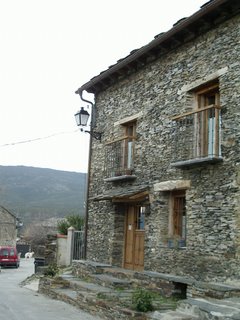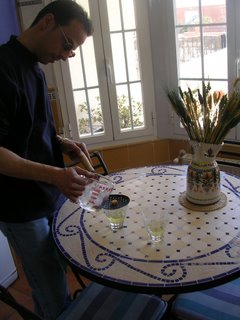SAL DeTRAGLIA'S VIRTUAL TAPAS BAR
Observations on food, drink, sport, life and silliness in the US, Spain...and beyond! [Copyright © 2004-2016. All rights reserved.]
Thursday, March 30, 2006
Monday, March 27, 2006
DAYS OF WINE AND...MORE WINE.

I come from a long line of great wine drinkers. This should not, however, be confused with coming from a long line of drinkers of great wine.
My paternal grandfather made home-made wine in the basement of his New York home. According to family archives, it tasted better in a salad bowl than in a wine glass.
My maternal grandfather attributes his longevity (ninety years old and counting!) to a lifetime of jug-wine consumption. That, and managing not to get blown-up during World War II.
My parents inherited the old geezers’ passion for wine, and mercifully raised the bar on quality. They refuse to drink any wines poured from a bottle with a screw-off cap.
But I, alas, have outdone them all. That’s because I am living in Spain—a land of outrageously good wines at outrageously low prices.
According to several websites that I consulted, Spain is the world’s third largest wine producer—trailing only Italy and France, respectively. I feel somewhat responsible for this achievement. Supply is, after all, driven by demand—and I contribute a helluva lot of demand to our domestic wine industry. If I should move to another country, Spain might quickly drop to fifth place.
This wasn’t always the case with me. When I moved to Spain six years ago, I was a confirmed beer drinker. My greatest passion was Belgian ales...with the surprisingly excellent US microbrews coming in second, and British Real Ales (bless you, CAMRA!) a close third. I wore this as a badge of honor. I was proud to be a connoisseur of fine beers, and rejected the perceived pretentiousness of the world’s wine drinkers.
My first brush with Spanish wines after moving here did little to realign those passions. Where did that first brush occur? At Spain’s many “menus del dia” (i.e., those ultra-cheap, three-course lunches that nearly every Spanish bar and restaurant offers during the workweek).
I was delighted to find that a half-liter of wine—and in some cases, an *entire* bottle—is included within the price of each menu del día. And I was even more delighted to find that I could drink this wine during lunch without fear of being branded a degenerate—as would surely be the case in the US. My delight evaporated when I tasted those wines, however, because they generally came in one of two categories—vinegary and overpoweringly vinegary.
On the bright side, at least I learned that the vinegar flavor could be tempered by drinking the wine ice cold. If only Grandpa had known this little trick.
But my attitude toward Spanish wines quickly changed when I ventured out of the bargain lunch sphere into the retail one. There was a small wine shop in the neighborhood in which I lived in Barcelona. In a small room at the back of the shop, the proprietor—a man whom I credit for showing me “the light” about wine...and whom I discredit for revealing himself to be a pathetic, drunken ass shortly thereafter—operated a tiny, hidden bar for “select” customers. This bar featured a small, ever-changing list of wines by the glass—each of which was hand-selected for its excellent price/quality ratio. It was as brilliant a marketing gimmick as it was an educational experience.
In tasting glass after glass—many of which the proprietor was too drunk to remember when tallying my bill at night’s end—I was able to explore (and finally appreciate!) the depth and quality of Spain’s vast offering of wines and wine regions.
The exploration continues to this day—although I have, by this point, developed some strong preferences. My favorite wines at the moment are from the region known as D.O. (Denominación de Origen) Toro—which produces a growing selection of big, strong, deep purple wines at ridiculously low prices. I am also deeply in love with the wines from D.O. Somontano, D.O. Costers del Segre and of course...my local D.O. LaMancha.
[Note to all wineries in the aforementioned regions: Please send the complimentary bottles and/or cases directly to my home—rather than to those Fanta drinkers in Expatica office.]
Apparently, I’m not the only one who believes that Spain’s wines are world-class bargains. At least once per month, some friend or co-worker from the US forwards me an article from the New York Times, Washington Post, Chicago Tribune or other publication in which the food critic or wine editor gushes about his latest “find” from Spain. If only they knew that I’m buying the same wines locally for 25-50% less.
If there’s a downside to Spain’s outstanding-yet-cheap wines, it’s that they are so...so...outstanding-yet-cheap. When I lived in the US, at least I could rely on my own tendencies as a world-class cheapskate to keep my wine consumption under control. A reasonably good bottle from Napa or Sonoma costs at least $10 in the US...and that hurts! But here...I can—with a little bit of research—buy a fantastic bottle of Spanish wine (for example, Finca La Estacada joven) for under 4€.
4€!!! That’s less than a bottle of Night Train, for God’s sake!
So...what’s my incentive to moderate? Some people may say “health reasons”...but I’m not convinced. If you want to debate this point further, however, then go talk to my ninety year old grandfather.
Saturday, March 25, 2006
Friday, March 24, 2006
HEY MAN...YOU GOT ANY 'STACHE?

I wasn't, of course. It was just a combination of bad lighting and a five o'clock shadow. In fact, I haven't worn a 'stache since I posed for Brawny paper towels back in 1972.
But I had a bit of freedom this week, and figured..."what the hell!" I might as well grow a quick one. So here is the result after four days. I opted for a Frank Zappa meets Pancho Villa look...and threw in a Roberto Duran-type glare for good measure.
I don't know if I should shave it off...or buy a Harley-Davidson.
Wednesday, March 22, 2006
ABSINTHE MAKES THE HEART GROW FONDER.

Check it out by clicking here.
Oh, and Mr. Big Finn... please take special note of the recipe at the end of the article.
Monday, March 20, 2006
SAUSAGE FEST!

“Sal...¡ven! ¡Ven aquí!”
I dropped my shovel and walked over to his house. Jesús whipped-out a cylindrical, foil-covered package and handed it to me.
“Wild boar sausage. I killed it myself. Very good with a glass of wine.”
I don’t know how many Hashers suffered bullet wounds so that I could be eating wild boar sausage (and drinking a glass of wine) while typing this post...but it was indeed a worthy sacrifice.
I’ve said it before, and I’ll say it again...Jesús is just alright with me.
Friday, March 17, 2006
Thursday, March 16, 2006
LOOKING FOR COMEDY IN THE SPANISH-SPEAKING WORLD.

Someone once said that, “A little knowledge is a dangerous thing.” That’s especially true when “little knowledge” pertains to a foreign language.
For those of us who were not born with the linguistic gifts of the average Belgian, navigating the peaks and valleys of daily life in Spain—in Spanish—can be fraught with peril. Peril, that is, not to the body—but rather, to the ego. Why? Because in the hands of the lazy or ill-prepared, a little knowledge of Spanish can lead to, at best, a good laugh—and at worst, an acute case of foot-in-mouth disease.
Here are some examples of what I’m talking about. Many of these were taken from my own checkered history of bilingual ineptitude. Others (particularly the less naughty ones) were the products of a brainstorming session with my good friend, fellow US expat and Vaughan Radio on-air personality, Drew Crosby.
EXAMPLE 1: “DYC.”
Based on a poorly-controlled, roundly unscientific study I’ve conducted over the past six years, the most popular liquor in Spain is Dyc. Dyc is a Scotch-style whiskey. It is typically mixed with Coca-cola and guzzled in disturbing quantities by twenty-something Spanish men. It’s also my first (and perhaps favorite) example of a false cognate. Why? Because this product’s name is pronounced “deek.”
That’s right...“deek!”
Why-oh-why some misguided marketing executive decided to name a brand of whiskey after the English slang word for male genitalia is beyond me. Perhaps he viewed globalization as passing fad.
But it gets worse. When Spaniards place their orders with a bartender, they don’t ask for “Dyc.” No...they ask for “Whiskey Dyc.”
Spelled differently but pronounced the same, the term “whiskey Dyc” in English slang means—are you ready for this?—alcohol-induced impotence.
Ironic, isn’t it? That which Spanish men routinely request, their English-speaking counterparts routinely deny.
EXAMPLE 2: “ESTAR CONSTIPADO/A.”
The Spanish phrase “Estoy constipado/a” means that the speaker’s head and chest are congested—usually due to a cold or allergy. But its English cognate (i.e., “I am constipated”) means congestion of quite another sort. Of course, none of my Spanish professors bothered to explain this subtle yet important distinction...and the results were predictable.
I was working in a large law firm in Barcelona, and sharing an office with another lawyer. My office-mate was a woman of immense beauty, elegance and professionalism. One morning during the month of March, she entered the office and slouched in her chair.
“Good morning,” I said. “How are you today?”
“Not very well,” she answered.
“Why? What’s wrong?”
“Estoy constipada.”
I sat there for several seconds, frozen in shock. And then, sensing an awkward silence, I uttered the first response that popped into my head.
“Well...what have you been eating for breakfast?”
EXAMPLE 3: “ESTAR EMBARAZADA.”
Pregnancy is a time of great joy. It’s certainly *not* a time of embarrassment—unless the father happens to be one of those idiots from Gran Hermano.
Unfortunately, the Spanish phrase “Estoy embarazada” implies otherwise to the English-speaking ear. It sounds remarkably close to “I am embarrassed.” But in fact, it means, “I am pregnant.”
Confusing, isn’t it? I suspect that I’m not the only man in Spain who has announced his pregnancy at a crowded dinner party.
EXAMPLE 4: “CUCURUCHO.” ALWAYS REMEMBER “CUCURUCHO.”
Even the wholesome world of ice cream can be a minefield. Take the Spanish word “cucurucho.” It sounds like the name of that wiry guy who delivered pizzas when you were a grad student in New Haven, Connecticut. But in fact, cucurucho means a cone for ice cream.
Please, please, please...remember the word “cucurucho,” because there exists a false cognate just waiting to humiliate you. That cognate is “coño.”
Let me be clear about one thing. This word does NOT mean cone. In Spanish, coño is [ahem] a gynecological term—but one so vulgar that no respectable gynecologist would dare utter it outside the confines of a bowling alley. And it’s a word that I misused once, and only once.
I was in the seaside town of Javea; between Valencia and Alicante. It was a hot summer day, and I spotted a cafeteria with an ice cream bar. I flagged-down a waitress.
“Hello. I’d like two scoops of coconut ice cream, please.”
“Would you like it in a bowl?” she asked.
“No,” I answered. “I’d like it in a coño.”
Bless the professionalism of that presumably underpaid waitress. Looking down at her shoes, she briskly plopped two scoops onto a sugar cone. Only her furled brow and quivering lower lip hinted at the tsunami of repressed laughter that struggled to unleash itself from the confines of her convulsing throat. When I was told of my error later that day, I had only one thought. Thank God that I opted for coconut ice cream, rather wild cherry.
On a separate but equally-important note, take care to use the correct gender when ordering chicken in Spanish.
OTHER MISCELLANEOUS EXAMPLES:
A “ganga” is not something to run from. It’s something to run toward.
An “éxito” is not a way out. It’s a way up.
A “carpeta” isn’t something that’s thrown onto the floor. It is thrown into a drawer.
If you have high blood pressure, then it’s not sensible to be too “sensible.”
The phrase “en absoluto” does not mean “absolutely.” To the contrary, it means “to the contrary.”
And always remember...“cucurucho” means cone.
Wednesday, March 15, 2006
AND NOW FOR AN OPEN LETTER TO THE REST OF THE WORLD.
Dear rest of the world:
I am pleased to announce that on this 15th day of March in the Chinese year of the dog, I have packed away my blue jeans and broken-out my shorts.
I will, nonetheless, re-evaluate my wardrobe sometime around Thanksgiving.
Sincerely,
Sal
(On behalf of himself, his thighs and his calves...all of which are approaching a lovely shade of bronze)
Sunday, March 12, 2006
MY NAME IS SAL, AND I’M ADDICTED TO LAZYTOWN.

Spain’s Playhouse Disney channel started broadcasting LazyTown last year, and Inés and I were immediately hooked.
LazyTown’s central premise is encouraging kids to lead healthy lifestyles—with particular emphasis on exercise, eating fruits and vegetables, tooth brushing (“Twenty times up; twenty times down...”) and getting lots of sleep (“8:08...time for bed”). This may not seem revolutionary on its face, but the first time you watch LazyTown...you’ll immediately notice that it’s no ordinary kiddie show.
No other show looks like LazyTown. It uses a seamless mixture of live actors, puppets and computer generated images (CGI). The set design is funkalicious. None of the props have straight lines or right-angles—so things like buildings, furniture and picture frames look like they’re being slowly sucked into a black hole. The color scheme is big, bold and primary. The show has that distinct Yellow Submarine feel to it. Yellow Submarine, that is, with an extra hit of brown acid.
No other show sounds like LazyTown. Some of the actors have odd accents and, at times, use odd sentence structures. This drove me nuts during the first episode. I just couldn’t place the accent. So I carefully read the closing credits, and got my answer—LazyTown is filmed in...are you ready for this?...Iceland (for God’s sake!)!
LazyTown also has amazing song and dance numbers—full of tight choreography and funky, complex camera angles. And the songs are very, very sticky on the brain. The song “You are a Pirate” has been playing in my head for the past six hours. I’m sure that I’ll be labelled a dork for admitting this, but...I actually have several LazyTown songs downloaded into my iPod. Why do you think I run so much?
I don’t know how much it costs to produce an episode of LazyTown, but it must be a fortune. And since you’ll all be programming TiVo to record all LazyTown episodes from this day forward (screw the The Sopranos!), let me give you a quick rundown on the cast of characters:
SPORTACUS: He is a super hero who comes from an island in the North Sea. He lives in a red, white and blue “airship” (i.e., blimp) that runs on pedal-power. Sportacus is so full of energy that he makes Iggy Pop seem like Abe Vigoda. He jumps, cartwheels, handsprings and flips through the air instead of walking. He does one-armed push-ups for relaxation. He has a crystal on his chest that beeps whenever “Someone’s in trouble!” Then he flips across town and saves the day. Sportacus gets his energy from two things: plenty of sleep, and plenty of “sports candy” (i.e., fruits and vegetables). The actor who plays Sportacus is actually a world-class athlete. He was the two-time aerobics champion of Europe. And believe it or not, the bastard is in his forties. There must be something to that sports candy stuff.
STEPHANIE: She is the mayor’s niece, and is visiting LazyTown for the summer. She has pink hair and sings most of the songs. The actress was in the Broadway production of Oklahoma, and it shows.
PIXEL: He is a rasta-kid who is only interested in computers and playing video games.
ZIGGY: He is the youngest kid, and is only interested in eating candy.
STINGY: He is the selfish rich kid that doesn’t like to share. His favorite line is, “It’s mine.”
TRIXIE: She is the little girl who looks like Bjork with three ponytails. Trixie is the prankster; always playing practical jokes on others.
MAYOR MILFORD MEANSWELL: He’s the mayor of LazyTown, and Stephanie’s uncle. He is a good-natured boob. His overbearing secretary/girlfriend leads him around by the nosering.
MISS BUSYBODY: The mayor’s overbearing secretary/girlfriend. She’s bossy, self-absorbed and spends half her life gossiping on the telephone.
ROBBY ROTTEN: My personal favorite. Robby is the laziest man in LazyTown. He lives in a dark, dusty factory under ground. He wants LazyTown to be the laziest town on the planet...which it was before Sportacus and Stephanie arrived. He especially wants the kids to stop playing and eating healthy foods. Why? Because energetic kids are noisy kids. Robby only wants peace and quiet so he can take naps on his fuzzy pink lounge chair. The actor who plays him is a comic genius. Reviewers often call him "the Jim Carrey of Iceland."
Anyway...each episode usually involves Robby Rotten undertaking some crafty plot to make LazyTown lazy again and banish Sportacus forever. His plans are usually incredibly elaborate and involve his wearing disguises. Robby inevitably makes some headway (often by tricking one of the kids into doing something naughty or unhealthy), but then Sportacus saves the day, the kids learn an important lesson, and then everyone sings and dances a number.
I never thought I'd say this, but...I like LazyTown even more than Teletubbies. And I loooove Teletubbies. But that's a post for another day.
Thursday, March 09, 2006
IN DEFENSE OF GUADALAJARA.

The conversation is always the same.
Madrileño: Hi! I’m Juan.
Sal: Hi, Juan. I’m Sal.
Madrileño: Where do you live, Sal?
Sal: Guadalajara.
[Perplexed, indignant silence.]
Madrileño: Why?
I have this conversation with non-Madrileños, too. The only difference is that the “Why?” is replaced with “Where?”
Well...I can no longer tolerate such flippancy toward my adopted province. In this week’s essay, I shall unsheath Excalibur and defend the honor of Guadalajara....or fall asleep trying.
Let’s start with the basics. Where is Guadalajara?
The objective answer is that it’s a province within the Automous Community of Castilla-LaMancha—located approximately fifty kilometers (i.e., thirty miles) east of Madrid. The subjective answer, however, varies widely depending on who you ask.
If you ask a Madrileño—a creature that habitually calculates distances in the same manner that he calculates dog years—he’ll burst into hysterics. Guadalajara is “a far-flung outpost—practically a gulag!—precariously plunked-down in the middle of a frozen, desolate tundra.”
If you ask me, I’ll tell you that Guadalajara is “a suburb of Madrid.”
And I’m right, of course. The trek from Guadaljara to Madrid is less than the daily commute to work for many Chicagoans or New Yorkers. Indeed, we enlightened Guadalajara dwellers have the best of both worlds. On the one hand, we have peace, quiet and plenty of free parking. On the other hand, I can walk out my front door and—thirty to forty minutes later—be sitting in a downtown Madrid curry house stuffing my face full of vindaloo.
Oddly, Guadalajara’s office of tourism has done little to promote the area’s curry-friendly attributes. But I digress.
Whenever I offer this proximity argument to skeptics, their response is predicatable. “If Guadalajara is so close to Madrid,” they sputter, “then why not just live in Madrid?”
The answer is simple. Economics! I could live in a sixty square meter condo in Madrid. Or, for the same price, I could live in a house in Guadalajara province that’s three to four times larger. That’s right...a house! With a basement that can accomodate a beer can collection, and a yard that can accomodate a big ol’ smoky barbecue pit.
Beer cans and barbecues may seem trivial to some, but I can assure you that they are sacred cows to an American.
Yet even when faced with these arguments, some naysayers continue to resist. And they’ll invetiable turn to that most squishy of topics...quality of life. “How,” they bluster, “can you live in a place without museums? Or opera houses? Theaters?”
To which I respond, “When was the last time you went to a museum or an opera house or a theater during the workweek?”
But lest you think I’m skirting the issue, let me be clear. We may not have Frank Gehry buildings or Velasquez collections here in Guadalajara, but we *do* have other cultural gems.
We have, for instance, world-class cuisine! In my earlier essay entitled “The Celebrity Roast, I discussed at length the soul-satisfying pleasures of our wood-fired meats—especially Guadalajara’s famed cabrito asado. But that’s just the tip of the iceberg. We also have Sopa Castellana—a big, heavy bowl of egg-topped, porky goodness that flaunts the convention that soup is light, healthy fare. We have Pisto Manchego—central Spain’s version of ratatouille. We have Queso Manchego—arguably the most famous of Spain’s cheeses. And for dessert, we have Bizcocho Borracho—a syrup-soaked, belly bomb of a pastry that’s tooth-achingly sweet and as dense as depleted uranium. Well...it is if it’s made correctly.
And we have nature! Enough plains, mountains, rivers, valleys and trails to please the most demanding hiker or Hasher.
And we have architecture! Unique architecture! Constructed not from undulating waves of glistening titanium, but from...chalkboards? That’s right! Guadalajara province is famous for its arquitectura negra (i.e., black architecture). The exterior of homes, churches and municipal buildings in some parts of this area are covered with layer-upon-layer of flat, thin, black sheets of slate.
Slate—for those of you born after 1985—is the material from which chalkboards were made in the good ol’ days before the invention of PowerPoint.
And let’s not forget that this region was the stomping ground of the most famous character in Spanish literature—Don Quixote. That’s Don Quixote *de LaMancha*...get it? Jeez!!! That fact alone makes me wonder why this essay is even necessary. Castilla-LaMancha, including Guadalajara province, ought to be Spain’s most popular region simply by riding on the Don’s coattails.
Unless...that same masterpiece is, in fact, the source of the region’s woes. Could it be that most Spaniards—and Madrileños in particular—poo-poo Guadalajara because they suffer an irrational fear of being attacked by windmills?
Thursday, March 02, 2006
INTERNET IS AN EXPAT’S BEST FRIEND.

My great-grandparents were Italian expats. They moved to the US nearly one hundred years before the Internet.
Expats without Internet! Can you imagine?! I don’t know how the hell they did it.
I, on the other hand, have come to rely on the Internet to solve nearly all of my expat-related woes. And I’m not just talking about e-mail. It goes *way* beyond that. Let me give you a few examples:
- REACH OUT AND TOUCH SOMEONE. The biggest misery for any expat is, most likely, missing his friends and family back home. That’s assuming, of course, that those same friends and family weren’t the reason that he fled the country in the first place. So how is one to keep in touch with his loved ones? Email, Instant Messaging and voice-over-IP calls (using services like Skype) are good options. But I recently discovered something even better. Something woooonderful! I discovered...video chat! Using software from services like Sightspeed (in my case), MSN Messenger or iChat, you can see and talk to friends and family—realtime!—through your computer screen. And it’s free! All you need is a high-speed Internet connection and a webcam. And a computer, of course. I’ve been video chatting with the US for months, and quite honestly...it’s almost like I never left home. I can join in a round of “Happy Birthday” during my nephews’ parties. I can trade barbeque tips with my brother. I can get lectured by my grandmother for being too thin. And it’s all “virtually” face-to-face. The burgeoning video chat world is, in my opinion, the greatest boon to expats since quinine pills.
- PLEASE! NO MORE BISBAL! Try as I might (and admittedly, I haven’t tried very hard), I’ve failed to acquire a taste for the syrupy Latino pop music that blankets the Iberian radio airwaves. For the longest time, I’ve wanted nothing more than to sit at my work desk and groove to some of my favorite radio stations from back home—or at the very least, a station uncorrupted by the likes of Bisbal, Chenoa or Bustamante. Then I began poking around the Internet and discovered the glorious world of Internet streaming radio! These are radio stations from around the world that broadcast directly through the Internet and out your computer speakers. There are thousands of them! Using a search engine like www.radio-locator.com/ or the “Radio” tab on your iTunes software, you can listen to blues from Chicago...or news from NPR and the BBC...or bossa nova from Paris. There’s even a station broadcasting from Antarctica—although I don’t imagine there are many Antarctican expats living in Spain.
- I’D KILL FOR A BUTTERMILK PANCAKE. I love the food in Spain. But I often find myself pining for foods back home. Carolina pulled pork! Or buffalo wings! Or a good ol’ American buttermilk pancake. Pining often turned into whining. But there’s no reason to whine. Why? Because if you’ve eaten it, then you can find the recipe on the Internet. Websites like www.epicurious.com have thousands of recipes just begging to be downloaded, printed and whipped-up on the Teka vitroceramica stovetop that you bought from El Corte Inglés. But...but...how can I make buttermilk pancakes if I can find buttermilk in Spain? Once again...the Internet comes to the rescue. Websites like http://chef2chef.net/kb/index/86-substitutions-other.htm will tell you how to make a reasonable facsimile of many ingredients that might be hard to find in your adopted country. Sorry, but they offer no suggestions for simulating vegemite.
- WHAT? ANOTHER BIRTHDAY?! During my first year in Spain, I spent more money shipping birthday, wedding and Christmas gifts to the US than I did buying the gifts in the first place. Then I wised-up, and started shopping “locally” via on-line stores like Amazon.[fill in the blank], www.llbean.com and countless others. This has saved me a lot of time and money—although I doubt that it will be much help to that guy from Antarctica.
- ALL I WANT IS A SOFT SHOULDER TO CRY ON. There are times when a distraught expat needs to comiserate with another who has walked in his moccassins. When this need arises, I find the expat blogger community to be an invaluable support network. Expat bloggers are tightly-knit group—but an open one. Joining is easy. All you need to do is find one good expat blog, and then check it’s sidebar. It’s likely to list links to dozens of other expat blogs. Then it’s just a matter of making the rounds each day and adding reasonably tasteful, intelligent comments to the various posts. You’ll quickly build a rapport with an expanding circle of virtual expat friends. And these folk—ranging from Canadians in Germany to Kiwis in Belgium to Italian/Turkish/Greeks in Canada—can be great sources of insight, advice and compassion.
If there’s a downside to the Internet, however, it’s that overreliance is likely to retard an expat’s learning and mastery of the local language. I’m a prime example of that.
But each expat must look within his heart and ask himself what’s more important? Knowing the correct use of the Spanish present subjunctive? Or knowing that one cup of warm milk mixed with one tablespoon of lemon juice will result in a passable substitute for buttermilk?



